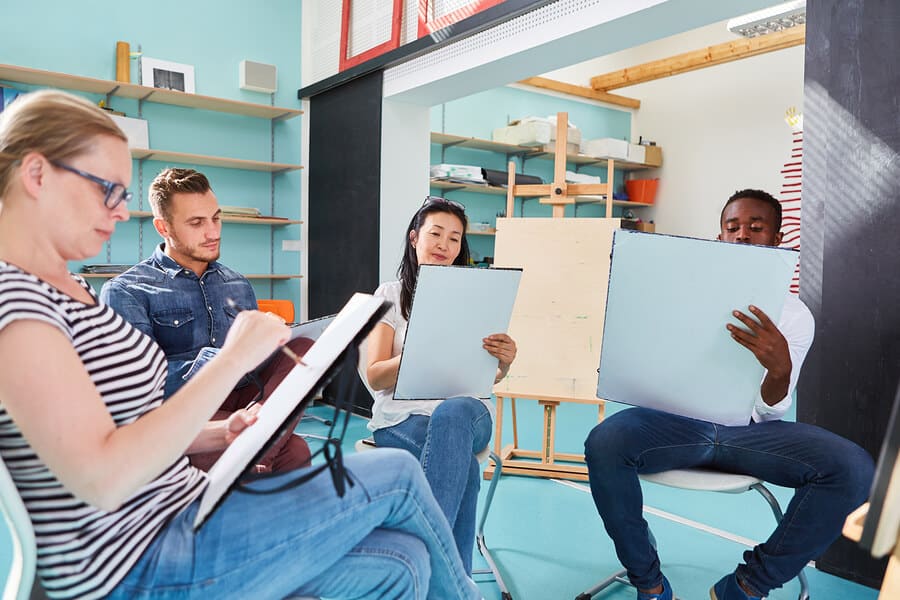
When a person decides to seek professional help for substance abuse, there are multiple options for what type of treatment he or she can undergo. Many addiction treatment centers offer clients different therapies, including individual, group, family, relapse prevention, music, and art therapy. These types of treatment are often used in conjunction to afford the person various methods of creative expression and healing.
Types of Art Therapy
In art therapy, the person uses creativity and imagination to create art that expresses him or herself positively and productively. The objective of art therapy is for the person to increase methods of communication to convey his or her experiences fully.
The kinds of creative forms typically used in art therapy include:
- Acting
- Dancing
- Drawing
- Painting
- Poetry
- Sculpting
Art therapy is a form of expressive group therapy that can help people to communicate thoughts and feelings that they feel unable to express with words. This therapy is particularly beneficial for those who have underlying psychological conditions related to their addiction, such as childhood trauma or mental illness.
Creating art is often a nonverbal process that increases the ways a person can express ideas and emotions. Thus, art therapy offers an opportunity to examine, understand, and solve problems in a person’s life that he or she may not feel comfortable discussing in a normal conversation. Moreover, art therapy uses multiple expressive forms to encourage patients to talk about their experiences to achieve insight and meaning.
Benefits of Art Therapy
It is not necessary to have artistic talent to engage in art therapy. A person only needs to be open to the experience and to participate actively to benefit from these sessions. Many people find that art therapy is a relaxing and fun way to confront some of the more complicated aspects of recovery.
The creative activity offers a means to process negative emotions and anxieties that can arise during treatment. After rehab, activities such as painting or drawing can be practiced throughout the person’s life as a venue to express feelings, explore further creativity, and relieve stress.
According to the American Art Therapy Association (AATA), art therapy is a mental health technique that can help the person in a variety of essential ways, such as the following:
- Resolving emotional struggles
- Building self-confidence
- Encouraging self-awareness
- Relieving anxiety
- Developing social skills
Socially, art therapy sessions can work as a form of group therapy and promote bonds among peers. As clients work together on guided projects, they can learn new methods of coping, share their responses to treatment, and practice their collaborative skills. Generally, art therapy can act as an initiation to the enjoyment of creative projects.

Art Therapy Techniques
There are three main techniques that art therapy commonly uses:
Gestalt Methods
In Gestalt techniques, the therapist helps the person work through his or her current emotions and experiences. The artwork might be employed as an initiation into a more profound conversation, or as a tool for the person to describe their thoughts by having them explain the artwork’s meaning from their own point of view.
Active Imagination
Using one’s artwork as a starting point, the person allows his or her mind to wander in spontaneous free associations, which opens the door to self-examination and discussion about feelings.
Third-Hand Approach
The third-hand technique includes help from the therapist. The person is in control of the overall creative vision, but the therapist aids with the creation of the art.
Using Art Therapy in Addiction Treatment
Recovery from addiction involves much more than detox and abstaining from the use of drugs or alcohol. Overcoming the disease of addiction demands an understanding of the factors that contribute to substance abuse and the reasons for resistance to healing.
Art therapy is beneficial for people undergoing substance abuse treatment because it offers them ways to understand and deal with their thoughts, feelings, and addiction. Both art and traditional therapies concentrate on helping a person exercise introspection and healthy coping skills. However, art therapy can be an excellent way for a person to investigate aspects of life that he or she might not be able to describe in a conversational manner.
When performed in a group setting, art therapy can also help people undergoing addiction treatment become closer and better understand one another’s feelings and experiences.
Getting Help for Addiction
Art therapy can be a wonderful way for a person to work through the emotions and issues that have caused or worsened his or her mental health and addiction. It provides them a safe venue to express ideas and feelings without using conventional talk-focused methods. Therefore, it can be an essential change for a person who is looking for something different than usual conversational therapy.
Harmony Treatment and Wellness offers comprehensive programs for the treatment of addiction that feature holistic approaches, including art therapy. Our services also include, but are not limited to, the following:
- Cognitive-behavioral therapy
- Individual/group counseling
- Substance abuse education
- Health and wellness education
- Music therapy
- Aftercare planning
If you or someone you love is struggling with a substance use disorder, contact us today! We are committed to helping those who need it most break the cycle of addiction and reclaim the healthy, fulfilling lives they deserve!
⟹ READ THIS NEXT: Health and Wellness in Recovery
